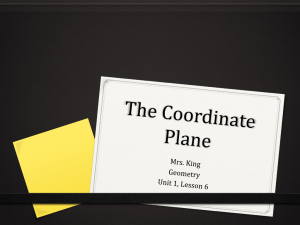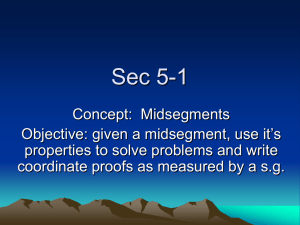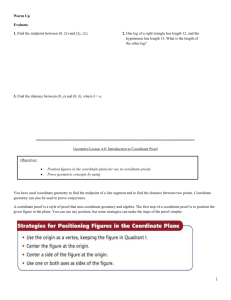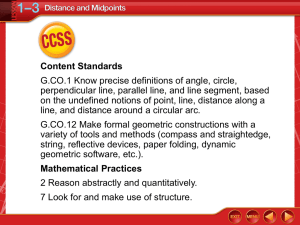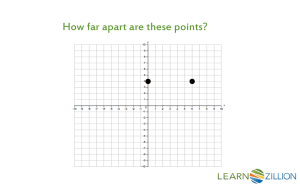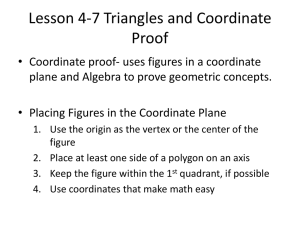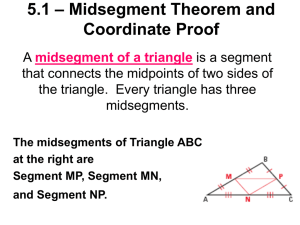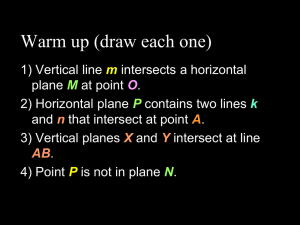Chapter 4-7 PowerPoint
advertisement
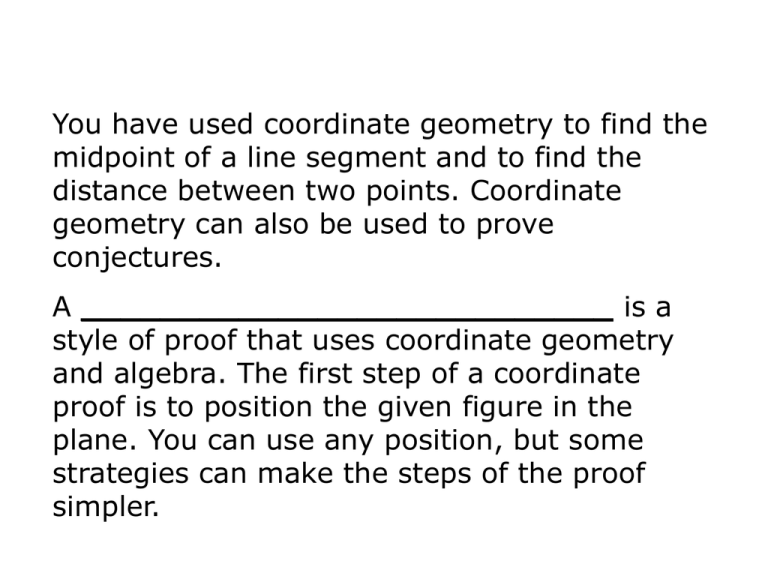
You have used coordinate geometry to find the midpoint of a line segment and to find the distance between two points. Coordinate geometry can also be used to prove conjectures. A ___________________________ is a style of proof that uses coordinate geometry and algebra. The first step of a coordinate proof is to position the given figure in the plane. You can use any position, but some strategies can make the steps of the proof simpler. Example 1: Positioning a Figure in the Coordinate Plane Position a square with a side length of 6 units in the coordinate plane. You can put one corner of the square at the origin. Check It Out! Example 1 Position a right triangle with leg lengths of 2 and 4 units in the coordinate plane. (Hint: Use the origin as the vertex of the right angle.) Once the figure is placed in the coordinate plane, you can use slope, the coordinates of the vertices, the Distance Formula, or the Midpoint Formula to prove statements about the figure. Example 2: Writing a Proof Using Coordinate Geometry Write a coordinate proof. Given: Rectangle ABCD with A(0, 0), B(4, 0), C(4, 10), and D(0, 10) Prove: The diagonals bisect each other. Example 2 Continued By the Midpoint Formula, Check It Out! Example 2 Use the information in Example 2 (p. 268) to write a coordinate proof showing that the area of ∆ADB is one half the area of ∆ABC. Proof: ∆ABC is a right triangle with height AB and base BC. Check It Out! Example 2 Continued By the Midpoint Formula, the coordinates of The x-coordinate of D is the height of ∆ADB, and the base is 6 units. A coordinate proof can also be used to prove that a certain relationship is always true. You can prove that a statement is true for all right triangles without knowing the side lengths. To do this, assign variables as the coordinates of the vertices. Example 3A: Assigning Coordinates to Vertices Position each figure in the coordinate plane and give the coordinates of each vertex. rectangle with width m and length twice the width Example 3B: Assigning Coordinates to Vertices Position each figure in the coordinate plane and give the coordinates of each vertex. right triangle with legs of lengths s and t Caution! Do not use both axes when positioning a figure unless you know the figure has a right angle. Check It Out! Example 3 Position a square with side length 4p in the coordinate plane and give the coordinates of each vertex. If a coordinate proof requires calculations with fractions, choose coordinates that make the calculations simpler. For example, use multiples of 2 when you are to find coordinates of a midpoint. Once you have assigned the coordinates of the vertices, the procedure for the proof is the same, except that your calculations will involve variables. Remember! Because the x- and y-axes intersect at right angles, they can be used to form the sides of a right triangle. Example 4: Writing a Coordinate Proof Given: Rectangle PQRS Prove: The diagonals are . Step 1 Assign coordinates to each vertex. Step 2 Position the figure in the coordinate plane. Example 4 Continued Given: Rectangle PQRS Prove: The diagonals are . Step 3 Write a coordinate proof. Check It Out! Example 4 Use the information in Example 4 to write a coordinate proof showing that the area of ∆ADB is one half the area of ∆ABC. Step 1 Assign coordinates to each vertex. Step 2 Position the figure in the coordinate plane. Check It Out! Example 4 Continued Step 3 Write a coordinate proof. Check It Out! Example 4 Continued Proof: ∆ABC is a right triangle with height 2j and base 2n. By the Midpoint Formula, the coordinates of Check It Out! Example 4 Continued The height of ∆ADB is j units, and the base is 2n units.
